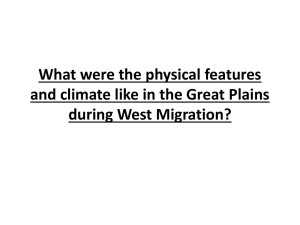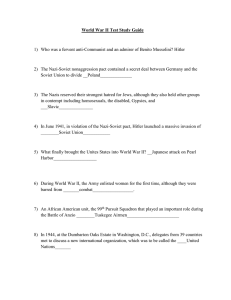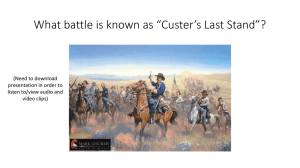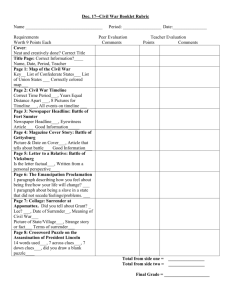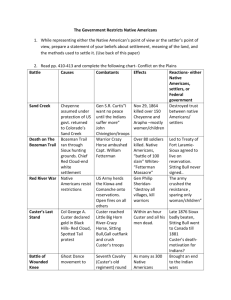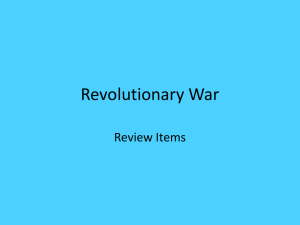Reconstruction & Westward Expansion TEST study guide TEST: Oct. 21-22, 2014
advertisement
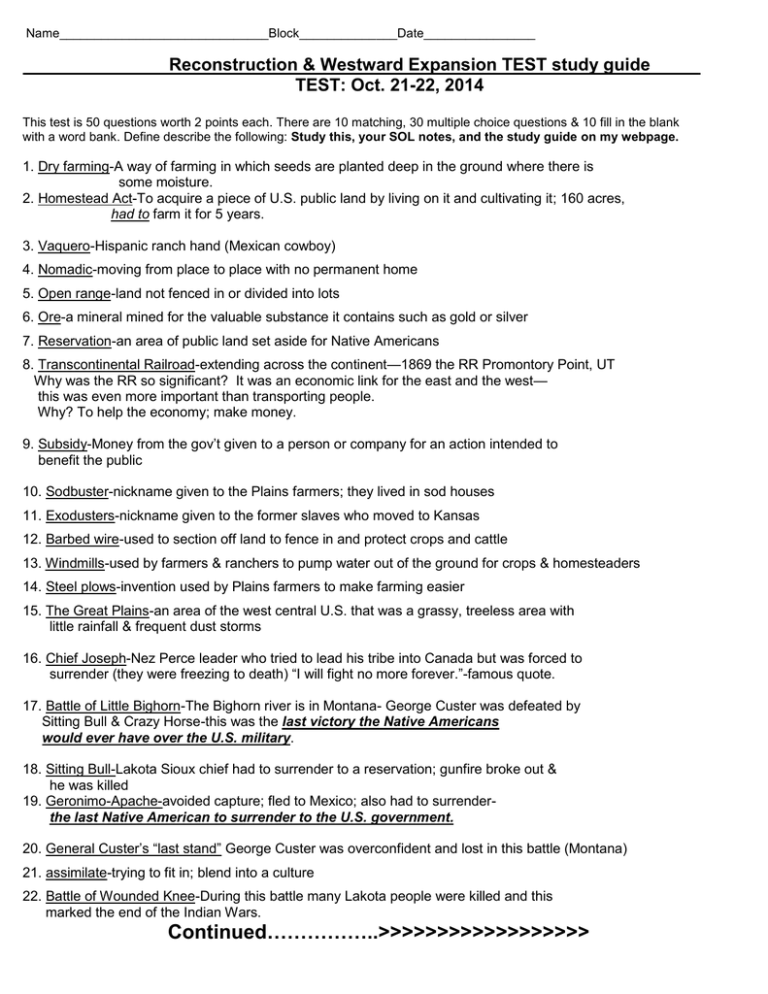
Name______________________________Block______________Date________________ Reconstruction & Westward Expansion TEST study guide TEST: Oct. 21-22, 2014 This test is 50 questions worth 2 points each. There are 10 matching, 30 multiple choice questions & 10 fill in the blank with a word bank. Define describe the following: Study this, your SOL notes, and the study guide on my webpage. 1. Dry farming-A way of farming in which seeds are planted deep in the ground where there is some moisture. 2. Homestead Act-To acquire a piece of U.S. public land by living on it and cultivating it; 160 acres, had to farm it for 5 years. 3. Vaquero-Hispanic ranch hand (Mexican cowboy) 4. Nomadic-moving from place to place with no permanent home 5. Open range-land not fenced in or divided into lots 6. Ore-a mineral mined for the valuable substance it contains such as gold or silver 7. Reservation-an area of public land set aside for Native Americans 8. Transcontinental Railroad-extending across the continent—1869 the RR Promontory Point, UT Why was the RR so significant? It was an economic link for the east and the west— this was even more important than transporting people. Why? To help the economy; make money. 9. Subsidy-Money from the gov’t given to a person or company for an action intended to benefit the public 10. Sodbuster-nickname given to the Plains farmers; they lived in sod houses 11. Exodusters-nickname given to the former slaves who moved to Kansas 12. Barbed wire-used to section off land to fence in and protect crops and cattle 13. Windmills-used by farmers & ranchers to pump water out of the ground for crops & homesteaders 14. Steel plows-invention used by Plains farmers to make farming easier 15. The Great Plains-an area of the west central U.S. that was a grassy, treeless area with little rainfall & frequent dust storms 16. Chief Joseph-Nez Perce leader who tried to lead his tribe into Canada but was forced to surrender (they were freezing to death) “I will fight no more forever.”-famous quote. 17. Battle of Little Bighorn-The Bighorn river is in Montana- George Custer was defeated by Sitting Bull & Crazy Horse-this was the last victory the Native Americans would ever have over the U.S. military. 18. Sitting Bull-Lakota Sioux chief had to surrender to a reservation; gunfire broke out & he was killed 19. Geronimo-Apache-avoided capture; fled to Mexico; also had to surrenderthe last Native American to surrender to the U.S. government. 20. General Custer’s “last stand” George Custer was overconfident and lost in this battle (Montana) 21. assimilate-trying to fit in; blend into a culture 22. Battle of Wounded Knee-During this battle many Lakota people were killed and this marked the end of the Indian Wars. Continued……………..>>>>>>>>>>>>>>>>>> Reconstruction: 23. Lincoln believed in preserving the Union more than punishing the South. He wanted to reconcile the North and the South. 24. What was a carpetbagger? 25. Robert E. Lee became President of Washington College. 26. Frederick Douglass was a former slave who fought to free slaves. He was also a powerful voice for human rights and civil liberties for all people. He also fought for the adoption of amendments guaranteeing voting rights. 27. The Fourteenth Amendment pertains to citizenship. 28. Examples of Jim Crow laws: literacy tests, poll taxes and segregated schools 29. What did the Freedmen’s Bureau do? 30. What did the Supreme Court case Plessy v. Ferguson (1896) do?
